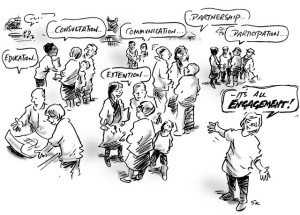Teaching is an Engaging Exchange, not a Superficial Standardization.
BY: David Greene
Originally posted on his blog here: https://dcgmentor.wordpress.com/2014/12/31/teaching-is-an-engaging-exchange-not-a-superficial-standardization/
The best teachers are communicators. They are listeners. They can figure out in a heartbeat how to help a student who is dumbfounded, misconstruing, or misspeaking. How they accomplish that depends on the particular student. They need to know their kids and be prepared and able to use a variety of means, starting with the simple idea of careful listening. Suppose a kid speaks up in class and makes an error. Too often, teachers will, for the sake of speed, make the correction and move on. What has that done? The kid still feels dumb; the class is less likely to remember it, because they always remember less when the adult says it.
The best teachers know how to respond when a kid makes an error. At some point, good teachers consciously or unconsciously learn to conceptualize what they teach, and as quick as a wink, figure out how to lead this mistaken student to the promised land of “I figured it out.” A quick series of clues, hints, and probing questions follow that allow him to succeed. Consciously, we figure out how much he needs. How far away is he from the right answer? Was it just a misspoken answer? Will repeating his answer give him the “oops” moment to self-correct? Can a simple example do it? A context clue? A rule of thumb? Maybe, an obviously wrong possibility is a clue. If nothing else works…ask another kid to help. Ahh, he’s gotten it. We can quickly move on. That whole exchange may have taken thirty seconds.
Benjamin Franklin said, “Tell me, and I forget. Teach me, and I remember. Involve me, and I learn.” Students learn best by action and discussion. How much talking should a teacher do? As little as possible. Your role is a moderator, a conductor, and a facilitator. How much should the kids do? They should do as much as possible: talking and interacting with teachers less than with each other, as a full class or in groups. Students are participants. The verb is to participate. It is why participation should be a major part of grades, at least 20 percent. Don’t we meet and participate in class far more than we test or write? Therefore, isn’t it the best place to assess student understanding and knowledge? Students get that. They see participation as a behavior to be expected and rewarded.
Therein lies the rub. In the top schools in the nation (usually the wealthiest and whitest), this usually isn’t much of a controversy, unless imposed on them by bureaucrats. Students who have the elite universities as their goals are taught even in elementary school the steps of analysis and synthesis. They are taught depth more so than breadth (depending on the subject). Time for in-depth activities is built into the curricula for students of all abilities. All existed way before Common Core was ever invented.
One way ninth-grade English students in Scarsdale High School are taught Shakespeare is via a Shakespeare festival. Each class performs one scene from the play they are all learning for each other in a daylong assembly program. That takes weeks of preparation, but those actors learn Shakespeare (and perhaps an appreciation of the bard) from the inside out.
Now, compare that to the minimally proficient standards to which we are holding urban students (Black, Hispanic, the poorest immigrants) “accountable.” Their Common Core Test prepped proficiency standards do not prepare them for any elite university. These standards barely prepare them for functional literacy during a time when our nation’s economic restructuring has all but made basic working-class jobs unavailable. Those that are available barely pay a decent wage.
Is that the equity the politicians claim they want?

No comments:
Post a Comment
Note: Only a member of this blog may post a comment.